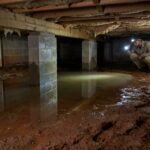Essential Guide to Foundation Repair: Ensuring Your Home’s Stability and Safety
When it comes to home ownership, there are few things as daunting as the prospect of foundation repair. The foundation is the very core of your home’s structure, much like the skeleton in our bodies. While it might not be as glamorous as kitchen renovations or a new roof, your foundation is crucial for ensuring your home remains standing tall (and level) through the years. This essential guide will enlighten you on everything you need to know about foundation repair, from identifying issues to finding the right professionals to help you out. So, grab a cup of coffee, put on your reading glasses, and let’s dive in!
Understanding Your Foundation
First, let’s take a moment to appreciate what we’re talking about here. Foundations come in various types: concrete slabs, crawl spaces, and basements. Each type has its own advantages and challenges, but all share one commonality — they need to be maintained properly to support the weight of your lovely abode.
Concrete slabs are typically found in warmer climates and are poured directly onto the ground. They’re great because they’re quick to install, but if the soil beneath shifts, you can start facing issues faster than you can say “cracked slab.”
Crawl spaces are a bit more … well, crawly. These spaces allow access to plumbing and wiring and provide better ventilation compared to concrete slabs. However, poor drainage can lead to moisture issues, and we all know that mold isn’t exactly the life of the party.
Basements, on the other hand, provide extra living space and storage but can sometimes feel like the depths of an abyss if not properly managed. Waterproofing becomes essential here, especially during heavy rains.
Signs of Foundation Trouble
Now that we’ve established the foundation of our discussion (pun intended), let’s explore how to recognize when your foundation is in trouble. Ignoring these signs is like ignoring your pet goldfish when it’s doing backflips — something is definitely amiss.
1. Cracking Walls and Ceilings: If you notice cracks in your walls or ceilings, especially if they’re expanding or growing in number, it’s time to investigate. Small hairline cracks can be normal, but large gaps are often harbingers of deeper issues.
2. Uneven Floors: Ever felt as if your house is giving you a tilt-a-whirl experience? If your floors are sloping or sagging, it might be telling you something. An uneven floor could indicate that your foundation is settling unevenly, which is not ideal.
3. Doors and Windows Sticking: If your doors and windows suddenly act like they’ve joined a union and go on strike, it could be due to foundation movement. When the foundation shifts, it can alter the frame of the house, causing those pesky openings to misalign.
4. Gaps Between Walls and Trim: Have you noticed spaces forming between walls and ceilings, or walls and trim? If so, your foundation may be experiencing some stress. Think of it as your home giving you a gentle reminder that it’s time for a check-up.
5. Exterior Cracks: Take a stroll around the outside of your home. If you see cracks in the brick, stucco, or concrete, this could be a sign that the foundation is shifting or settling in an unbalanced manner.
If any of these signs rear their heads, it’s best to consult a professional. Remember, while you may have a PhD in binge-watching home improvement shows, tackling foundation repairs is best left to those who know what they’re doing.
The Causes of Foundation Issues
Like pesky weeds in a beautiful garden, several factors can lead to foundation problems. Understanding them can help you prevent future complications. Here are some common culprits:
1. Soil Movement: The type of soil under your foundation can play a huge role in stability. Expansive clay soils tend to swell when wet and shrink when dry, which can lead to movement in your foundation. It’s like your house is trying to do the cha-cha when all it really wants is to stand still.
2. Poor Drainage: Water is both friends and foes when it comes to foundation integrity. If rainwater isn’t adequately channeled away from your home, it can accumulate around the foundation, leading to erosion and other nasty problems. Investing in gutters and proper landscaping can help keep water at bay.
3. Tree Roots: If you have trees near your home, their roots could be seeking moisture from your foundation, leading to damage over time. It’s like trees want to become roommates with your house, but not in a good way.
4. Improper Construction: Sometimes, the root cause of foundation issues is simply poor initial construction. If the foundation wasn’t laid properly or the materials weren’t up to standard, it could spell trouble down the line. Always make sure to hire reputable contractors for foundation work.
5. Natural Disasters: Earthquakes, floods, and even heavy snow can wreak havoc on your home’s foundation. If your area is prone to such events, be sure to review your foundation’s resilience.
Seeking Professional Help
So, you’ve noticed a few signs that your foundation might need attention — what’s next? Enter the experts! Hiring a professional foundation repair contractor is essential for addressing serious structural issues. But how do you find the right one?
1. Do Your Research: Look for local contractors with strong reputations. Don’t just grab the first name you see; ask friends, family, and neighbors for recommendations. Reviews and ratings can also provide insight into a contractor’s quality of work.
2. Get Multiple Estimates: Don’t settle for the first estimate you receive. Get at least three quotes to ensure you’re getting a fair price. Remember, the cheapest option isn’t always the best; you don’t want to skimp on something as critical as your foundation.
3. Check Credentials: Ensure your chosen contractor has the necessary licenses and insurance. This protects you from liability should something go wrong during the repair process.
4. Ask About Warranties: A reliable contractor should offer a warranty on their work. This gives you peace of mind that if something goes awry after the repairs, you’ll have recourse.
5. Review Contracts Carefully: Before signing anything, read through contracts thoroughly. Make sure you understand the scope of work, timelines, and payment terms. Clarity upfront can avoid headaches later on.
Types of Foundation Repairs
When it comes to repairing a foundation, there are several methods available. The best solution depends on the extent and nature of the problem. Here’s a rundown of some common techniques:
1. Piering and Underpinning: This method involves installing piers deep into stable soil to lift and stabilize the foundation. It’s like giving your house a little boost, similar to how we all feel after a double espresso!
2. Slabjacking: If you have a concrete slab foundation that has settled, slabjacking may be the answer. This involves injecting a mixture beneath the foundation to raise and stabilize it. It’s essentially giving your slab a little air for support.
3. Wall Anchors: For bowing or tilting walls, wall anchors can be installed to stabilize and straighten them. This technique involves anchoring the wall to the ground, preventing further movement.
4. Waterproofing: If moisture is your main issue, waterproofing the foundation may be necessary. This can include installing drainage systems, sump pumps, or applying waterproof coatings to basement walls.
5. Crack Repair: For small cracks, epoxy injections can fill and seal gaps, providing structural support. It’s a quick fix but helps maintain the integrity of your foundation.
Preventative Measures
Once your foundation has been repaired, it’s essential to take steps to prevent future issues. Think of these measures as your home’s wellness routine — keeping it healthy and happy!
1. Maintain Water Drainage: Ensure gutters and downspouts direct water away from your home. Typically, a distance of at least 10 feet is a good guideline.
2. Landscaping Considerations: Avoid planting large trees too close to your foundation. Additionally, consider grading your yard to slope away from your home to prevent water pooling.
3. Monitor Soil Moisture: During dry months, keep an eye on the soil around your foundation. If it gets too dry, water it gently to prevent excessive shrinkage.
4. Regular Inspections: Schedule periodic inspections of your foundation and surrounding areas, especially after heavy rains or significant weather events.
5. Address Issues Promptly: If you notice any signs of foundation trouble, address them quickly before they escalate into larger problems. Like weeds, the sooner you tackle them, the less likely they are to take over.
Conclusion
Foundation repair may not be top of mind when you think about homeownership, but ensuring your foundation’s stability is crucial for the safety and longevity of your home. By recognizing the signs of trouble early, understanding the causes, and seeking professional help when needed, you can keep your home standing strong against the tests of time and nature.
With a proactive approach to maintenance and repairs, you can rest easy knowing that your foundation is as strong as ever. And while it may not be as exciting as picking out new curtains, knowing that your home is safe and secure is a reason to celebrate! After all, a happy home starts with a solid foundation.


